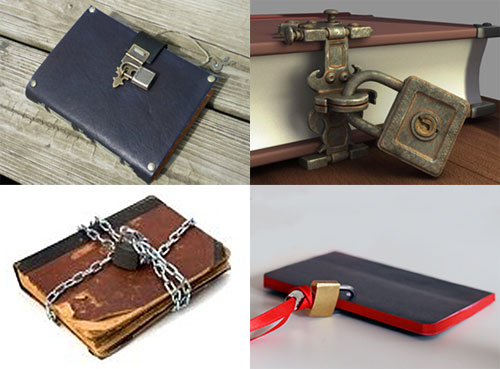A Bizarre presentation for the Seven Keys to Baldpate effect, inspired by Jack Bridwell’s use of a locked book (“Locked”, Magick, no. 190).
Requirements and setup
You’ll need what appears to be an old book (or loose sheets in a folder) on witchcraft or some other dangerous occult topic. It doesn’t have to be imposing; if the topic is appropriate, even a small, unassuming book can be effective. It only needs to look old (100 years or more) and have stiff covers, ostensibly so that it’s not possible to peek at the contents when the book is locked. The pages are never shown, so they can be blank.
The book is be locked with a padlock in some fashion (see illustration). The padlock and locking mechanism don’t have to look old, but they must look extremely solid.
Any suitable method for the Seven Keys effect can be used. The key that opens the lock is on a chain around your neck, under your shirt. The other keys are kept in a clear plastic bag. Keep the book and the bag of keys in a small, wooden chest, to make it look valuable, or wrap the book in a piece of rich, heavy cloth.
Adjust and adapt the sequence and handling below for the method you use.
Presentation
“Knowledge is power — and that makes it dangerous. Throughout history, books have been banned, sometimes even burned, to keep certain knowledge out of the hands of the masses. And then there are books that contain knowledge that is so powerful, so dangerous, that their very existence is kept secret. Such books are carefully guarded and almost impossible to find… almost.
“This is one of these books. It’s one of the more dangerous ones. Blood has been spilled for it….
“It’s protected in several ways. As you see, it is locked — you need a key to open it. It comes with several, but these are a bit… odd. Here, try them yourself.
“As you saw, none of these keys open the lock. They are decoys, made to confuse those who would steal the secrets in the book. There is only one key that opens it — this one.
“There’s another way in which the book is protected. Allow me to show you.” The keys are dropped into the bag. Remove yours from the chain and drop it in the bag last. Have a spectator shake the bag, then dump the keys in the middle of the table. Each participant slides a key toward him/herself, leaving one for you.
“Now let’s say that each of you wants the knowledge contained in this book for yourself, and that you know that there are decoy keys in addition to the real one. I would like each of you to decide whether to keep the key you have, or exchange it for someone else’s key — including mine. You can keep exchanging keys until you’re satisfied with the one you have.” Give every spectator a turn.
“I mentioned earlier that the book is protected in several ways. In addition to the lock and the decoy keys, it is said that the book is also protected by spells. Should the good key be lost or stolen, it will invariably find its way back to its rightful owner. Sir, would you please unlock the book for me?” Point to the key in the middle of the table and hold the book so that the assisting spectator can open the lock for all to see. Send the spectator back to his seat, if standing, and allow the effect to sink in. If you like, you can hold the book toward yourself, briefly glance at a few pages, then close it. In any case, be sure to lock it.
Clean up — remember to put the key in the lock back around your neck — and as you turn to put everything back into your case, stop and address the audience. “It is also said that, should someone try to open the book by force, the pages will immediately turn to ashes.” To end on a light note: “But considering how much I paid for this, it’s not something I want to test,” smile and put the props away. For a darker ending, say, apparently in controlled anger: “Considering the price I paid for this — and I don’t mean money — that’s not something I’m about to test.” Put the props away with a sullen expression, pause for a moment, take a deep breath, then face the audience again and continue with your next effect.


Leave a Reply
You must be logged in to post a comment.